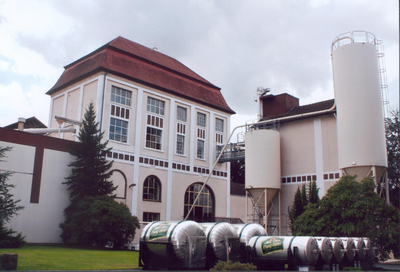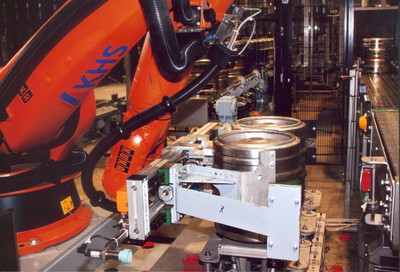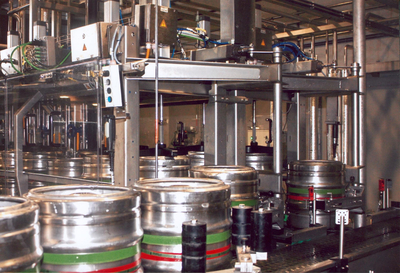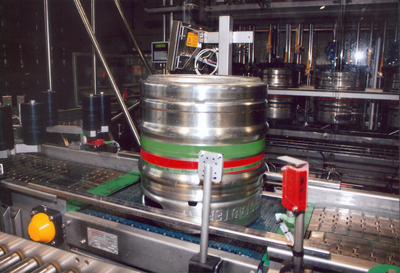
"From the Region for the Region"
Pfungstädter, the private brewery in Hesse, invests in KHS keg line with numerous extras
Frank Schneidermann*
Pfungstädter is the largest independent private brewery in the German state of Hesse today. This position can largely be attributed to a high degree of far-sightedness, which runs through the corporate history like a thread. The origins of Pfungstädter Brewery date back to 1831, the year when master brewer Justus Hildebrand opened a tavern with its own small brewery in Pfungstadt's neighboring village of Hahn. The company founder quickly realized that substantial growth could only be achieved with a larger brewery. In 1846, he therefore invested in a large plot of land in Pfungstadt itself, had deep cellars excavated, and became one of the pioneers of bottom-fermented beer in Germany. Pfungstädter Brewery is benefiting from his foresight to this very day. The 50,000 m² site enables the brewery to operate facilities that can easily handle a current output of 440,000 hectoliters of beer a year, produced in a wide range of styles and varieties. Another fact further illustrates just how forward-looking Hildebrand was: During his lifetime, he stipulated that only his descendants should be able to hold shares in the brewery. The number of shareholders has since grown to around 90, which means that the annual shareholder meeting at Pfungstadt is tantamount to a huge family gathering. Management Spokesman Heinz-Dieter Seifert regards Pfungstädter's status as a private brewery as an asset. Seifert is pleased with the result, saying, "It is a safeguard for the future stability of the brewery."
Far-sightedness goes hand in hand with stability
Stability is another key attribute of Pfungstädter Brewery. With its Pfungstädter premium beer brand, it has remained the brewery from the region for the region over the centuries. In order to cater for the different tastes of all target groups in the region, Pfungstädter Brewery now offers a range of beers that is unequalled. The Pfungstädter and Justus Hildebrand brands – the latter in memory of the company founder – cover no less than 17 different beers and mixed beer beverages, including Pils, Schwarzbier, Maibock, wheat-grapefruit-orange, and non-alcoholic wheat beer. With a sales share of around 70%, Edel Pils remains the big seller within the Pfungstädter premium range. Export has a sales share of around 15%. The remaining 15% is comprised of wheat beer varieties and other products.
* Sales, Germany, KHS AG, Dortmund, Phone: +49 (231) 569-1104
Focus on Pfungstädter and Justus Hildebrand premium beer brands
With a 50% share of total production, the Pfungstädter and Justus Hildebrand premium beer brands are clearly the brewery's star products. Other beer brands produced at Pfungstadt include Treiber, Köthener, Sachsenkrone, and Schönberger. Pfungstädter Brewery acquired brand rights for these beer brands in the 1980s and 1990s. This is fully consistent with the company policy, since each of these beer brands serves its own target group. Treiber, for example, is positioned in the attractively priced segment of the Pfalz region. Köthener is a medium-priced beer brand, while Sachsenkrone is a low-price product distributed in Thuringia, Saxony, and Saxony-Anhalt. Schönberger is a medium-priced beer brand for the Odenwald region. Together, Köthener and Sachsenkrone have a sales share of around 40%, while Treiber and Schönberger each have around 5%.
"With the acquisition of brand rights, we have given loyal consumers the opportunity to continue enjoying 'their' beer brands in future," says Seifert. "Nevertheless, the main focus of our brewery continues to be on production and marketing of the traditional Pfungstädter premium beer brands."
Pfungstädter is a key player in the region
The brewery actively maintains the high regional profile of Pfungstädter premium quality beers through its presence at a wide range of regional events. At public fairs, various sporting activities, music festivals and gatherings of local associations, Pfungstädter is in on the act. It also organizes its own events at the brewery site, including parties for the young adult target group and the Pfungstädter Freundschaftsfest for the whole family. Its brewery tours are also very popular. According to Seifert, the brewery tours alone attract more than 20,000 visitors each year.
Regional raw materials
Rüttger Stieg, Technical Manager at Pfungstädter Private Brewery, explains: "This level of interest in our brewery is a clear indication that consumers regard Pfungstädter as premium quality beer." In order to be able to maintain top beer quality, Pfungstädter Brewery likes to use high-quality raw materials from the region – just as it did in the early days. For example, all the barley used for the beer comes from certified Hessian farmers, as documented by the Geprüfte Qualität Hessen seal of quality for Pfungstädter premium beers. The consistent use of high-quality regional raw materials is one of the factors that has led to Pfungstädter premium beers recently receiving numerous awards – as it did in its beginnings – including several gold medals from the DLG [German Agricultural Society]. "We are particularly proud of the fact that we are IFS (International Food Standard) certified", says Stieg.
Two-percent export share offers scope for growth
This is no doubt one of the aspects that opens up export opportunities for Pfungstädter premium beers, which, incidentally, is another area where the company founder demonstrated his far-sightedness. In the mid 19th century, he was already distributing to customers in France, England, the United States, Africa, Australia, and China. Today, the main export markets are Italy, Spain, and France in Europe and above all Thailand, Japan, China, and Australia abroad. "Our two percent share of exports offers scope for growth," says Seifert. "We are also keen to market Pfungstädter premium beers at premium prices outside Germany."
1,500 restaurant businesses sell Pfungstädter premium beers – mostly in kegs
Outside Germany, Pfungstädter premium beers are currently sold primarily in returnable containers. "With a strong increase in export activities, this will change," says Stieg. Within the region, Pfungstädter Brewery deliberately relies on a purely returnable strategy and will continue to do so in future for environmental reasons. The focus is on returnable bottles, which make up around 85% of Pfungstädter's total beer sales. The remaining 15% is sold in kegs. The situation is slightly different for the Pfungstädter premium beer brands, where the share of kegs is around 25%. The main reason for this is that Pfungstädter premium beer brands have a strong position in the regional restaurant trade, as evidenced by the fact that currently around 1,500 restaurant businesses sell the beer brand "from the region for the region".
Traditional kegs continue to dominate the restaurant trade. In order to meet consumer demand in this sector, the brewery offers its main top- and bottom-fermenting Pfungstädter premium beers racked in kegs. The traditional radler or shandy (a mixed beer beverage) is also available in kegs. In addition to the standard 30-liter and 50-liter keg sizes for the German restaurant trade, Pfungstädter Brewery also offers 20-liter and 10-liter kegs. While 20-liter kegs are chiefly intended for exports to Italy, 10-liter kegs with a Bavarian-style tapping system are sold directly to consumers. It successfully combines convenience with the fun of tapping your own beer and is therefore ideal for private parties.
KHS keg technology is a key component
Pfungstädter's motto is quality, quality, and yet more quality. "Outstanding product quality is one side of the coin," Stieg explains. "The flip side is filling and packaging equipment, which must be of the highest caliber in order to maintain top beer quality." When it came to investing in new keg line technology, the company chose KHS as supplier without any hesitation for several reasons. No. 1: The existing keg line had also been supplied by KHS and had operated very reliably over the decades. "We acquired the keg line in 1983, and it worked very satisfactorily right up to its final day of operation," says Stieg. No. 2: KHS keg technology complies with stringent hygiene standards for keg washing and ensures optimum filling results. No. 3: KHS is a "one-stop shop". In the Pfungstädter solution, KHS keg equipment is directly linked to a sophisticated depalletizing and palletizing system, ruling out interface problems right from the beginning. No. 4: KHS managed to integrate the new line with a capacity of between 160 and 180 kegs per hour (depending on the keg size) on exactly the same footprint as the previous 120 keg-per-hour line. Seifert says, "Installation was very fast indeed. It took just two weeks from assembly to operation, thanks to the terrific teamwork of KHS and our brewery staff."
Versatile robot
The first and last station within the new KHS keg line is the Innopal RK 6 robot, which masters the palletizing and depalletizing of kegs in addition to numerous other tasks. The Innopal RK 6 is extremely versatile. The 6-axis robot is capable of controlling up to 25 target positions in 8 functional units.
Pallets containing empty kegs are unloaded by forklift truck and conveyed to the depalletizing station by a roller conveyor. Before the Innopal RK 6 picks up the kegs, they are centered using an Innopal PZ 1 gantry-type centering device. The Innopal RK 6 then simultaneously picks up two 20-liter, 30-liter, or 50-liter kegs or three 10-liter kegs. Thanks to the simple format part changeover at the gripper head, the Innopack RK 6 can be quickly adapted to cope with different keg sizes. After picking up the kegs, the robot takes them to the cap stripper, where the fitting position is queried. If the fitting on one of two kegs that were picked up simultaneously is not detected, for example, this keg is turned after the keg with a correctly identified fitting has been passed on. The undetected keg is then returned to the cap stripper and the fitting position detection unit and, like the first keg, from there to the exterior washer over a conveying segment.
In addition to keg conveying, the Innopal RK 6 also deals with pallet handling, stacking empty pallets at two designated pallet parking stations when the line starts up. Once freshly filled kegs start arriving at the palletizing station, Innopal RK 6's range of activities again expands, it now places full containers on the freshly depalletized pallets, which have been conveyed directly from the depalletizing station to the palletizing station by pallet conveying segment. Once production stops, or if priority palletizing of full containers is required, the Innopal RK 6 then palletizes using the pallets stacked at the pallet parking stations.
Here, too, Innopal RK 6 picks up two or three kegs all at once. First, the robot turns the kegs, making a separate keg turner unnecessary. Next, the Innopal RK 6 moves to the capping station, which places caps on the keg fittings. The Innopal RK 6 then conveys the kegs to the labeling station, before depositing the load onto the pallet.
The Innopal RK 6 is able to respond flexibly to changing situations. If, for example, the filled container section is becoming crowded, the robot will focus on palletizing full containers. If the number of empty kegs in the system falls below a specified level, it will focus on depalletizing. An intelligent logic controller sets priorities, thereby ensuring a continuous keg flow within the line and associated high system performance.
Keg line efficiency partly in excess of 100 percent at the time of acceptance test
Acceptance test results indicate that the new keg line is highly efficient. While the line efficiency for the processing of 10-liter, 20-liter, and 30-liter kegs was between 90 and 95%, the results were even better for 50-liter kegs. This was because although a capacity of 160 kegs/hr was specified for 50-liter kegs, this figure was clearly exceeded by an actual output of almost 180 kegs per hour. "This is truly outstanding performance," enthuses Stieg.
Well thought-out exterior washing
After the depalletizing process, the Innokeg AK 1 deals with washing keg exteriors. The exterior washing process is carried out over several zones. The kegs are pre-washed with a caustic solution and mixed water. Optimally arranged spray nozzles, with spray patterns that are adaptable to the respective kegs, remove coarse impurities from the sleeve area and the shoulder of the keg. Main keg washing initially takes the form of intensive caustic treatment, followed by a further main washing of the keg using mixed water. Rinsing the kegs with fresh water is the last step in the washing process before the kegs leave the exterior washer.
Washing keg interiors using the pulsating spray process
The kegs move on to the Innokeg TRANSOMAT 5/1 Duo. Both washing and racking sections are equipped with one racking station and five active washing and sterilizing stations, plus one passive caustic soaking station. Due to the large number of washing and sterilizing stations, the Innokeg TRANSOMAT 5/1 Duo is also suitable for products, which usually require special treatment, one of these being Pfungstädter wheat beer. The intensive washing process means maximum microbiological safety. The fact that the correct quantity of cleaning agent is automatically added based on conductivity measurements makes the cleaning process particularly environmentally friendly and leads to a significant reduction in the consumption of cleaning agents.
The kegs are checked for residual pressure at the first Innokeg TRANSOMAT 5/1 Duo station. Any kegs that do not pass the residual pressure test are automatically channeled out. The first step in the keg washing process involves blowing out beer ullage with sterile air. This way, any liquid present in the keg is specifically removed through the ring channel. This is followed by pre-spraying with mixed water in order to rinse out coarse impurities.
Cleaning fluids are then introduced into the keg. Two caustics and one acid are used. The keg interior is washed using a pulsating jetting process, which produces an outstanding cleaning action on the inside surface of the keg (keg interior and riser pipe). This stage is followed by a rinse with hot water to reliably remove any clinging residue of cleaning agent in the keg, and a final blowout with steam. In addition to removing residual liquid, this final blowout with steam also sterilizes the keg. Any residual oxygen is displaced, thus creating ideal conditions for the racking process.
DFC® filling system for ideal racking results and targeted CO2 savings
For Pfungstädter Brewery, the filling system of choice is the DFC® (Direct Flow Control) system, which is based on volume flow control. With the DFC® filling process, it is sufficient to pressurize the kegs to a pressure that is slightly above the CO2 saturation level. This means that the carbon dioxide consumption is reduced by up to 40% versus conventional racking solutions. The direct control of the filling process by a regulator valve on the product feed makes the DFC filling process extremely precise. There is no loss of product due to keg overfill, nor is underfilling a problem. One of the key factors for maintaining the beer quality in the keg is minimum oxygen pickup. This is ensured by exact regulation of the volume flow at the start of the racking process, along with extremely low gas loss.
The kegs travel from the racker directly to the keg scales. "Good" kegs are finally sent to the Innopal RK 6 robot, which besides palletizing also deals with numerous other functions, as previously described.
The upshot: a keg line that meets all requirements
"KHS has provided us with a keg line that meets all our requirements," says Seifert. "Everything is perfectly controlled. In our opinion there is absolutely nothing which could have been implemented better," he adds.
With its innovative KHS keg equipment, Pfungstädter Brewery is now excellently prepared for an increasing demand in keg beer, although Seifert does not intend to actively pursue growth in this area. "Pfungstädter premium beer brands are sold to the restaurant trade and consumers at premium prices, and we intend to keep it that way." The company thus intends to continuously and qualitatively expand its range of activities in and around the current core sales area. "In this way, we want to continue to reach all consumers within our core market – and ensure that all consumers can reach us," says Ulrich Schumacher, Pfungstädter's Marketing and Sales Director.







